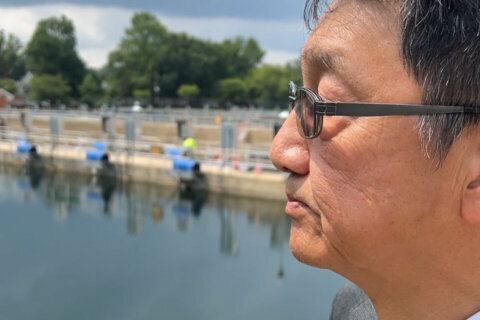These days, when it comes to new stadiums and arenas, it’s not just about the location being offered, but what else can be located there too.
It’s a lesson D.C. just learned the hard way.
“There’s a new economics now,” said Matt Winkler, professor of sports analytics and management at American University. “You need so many of the boxes checked for something like this. You know, you need mixed use, public-private, with a long term guarantee, but also a little bit of wiggle room.”
The new model Winkler describes is what was built in Georgia for the Atlanta Braves. While the relatively new stadium there arrived in what was already a thriving, suburban area where a lot of fans were located, the Braves also own a lot of the development rights around the ballpark area. Fans want more casual, low key settings inside the stadiums, so teams are looking to maximize available revenues outside.
That model is being copied by Monumental Sports & Entertainment, which owns the Washington Wizards and Washington Capitals, in its planned relocation of teams from the Capital One Arena in D.C. to a new, 70-acre arena site with surrounding entertainment complex in the Potomac Yard neighborhood of Alexandria, Virginia.
- ‘We are still in the game’: Mayor Bowser says DC is holding out hope that Wizards, Caps will stay put
- ‘This is monumental’: Capitals, Wizards owners partner up with Virginia for proposed arena, entertainment district in Alexandria
- New Capitals and Wizards Potomac Yard development would be a big win for JBG Smith
“The key is sort of owning the rails,” Winkler said. “And so a lot of the stuff that goes through that property, [Monumental owner Ted Leonsis will] have a big say on and for a long time, if you look at the proposed contract.”
How much control and how much ownership Monumental will have is still to be determined. Nothing is signed and set in stone yet, and lawmakers in Virginia will still be able to influence the final terms of the deal. But as the Commanders look for a new stadium, and the Baltimore Orioles continue to negotiate a new lease for Camden Yards, expectations have changed.
“That mixed use, owning properties for revenue generation and consumer engagement, those will be heavily in play,” Winkler said. “It’s holding those ancillary areas around the stadium’s footprint. That’s where you really maximize those things and can certainly aid the bottom line of a sports team.
“And let’s face it, if you look at salaries now for star athletes, they’re going up and up and up. And [teams] are trying ways like deferred payments to try and kick the can down the road,” he added. “So, it’s never been more important than now to make it all-encompassing, have those components we talked about, and also not losing your team or things like that.”
It’s a risk Oklahoma City residents weren’t willing to take. This week, they passed a 1% sales tax to fund a nearly $1 billion arena for the city’s only major league sports franchise, keeping the Thunder there until at least the year 2050.








